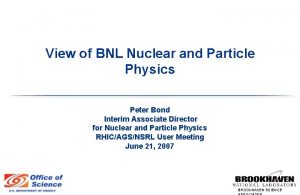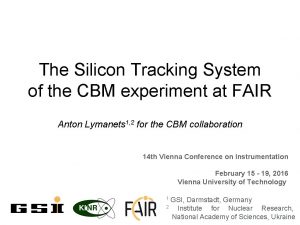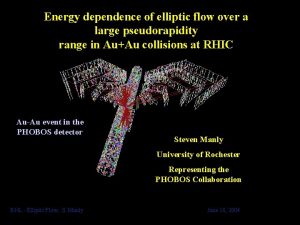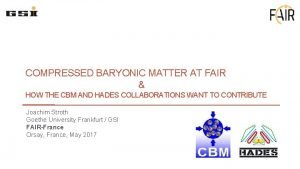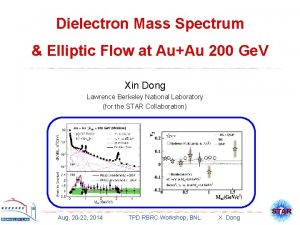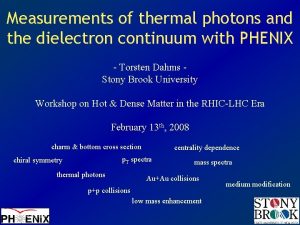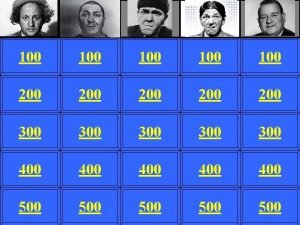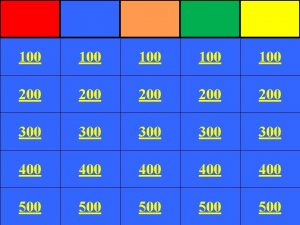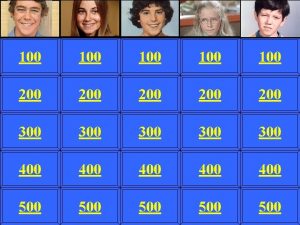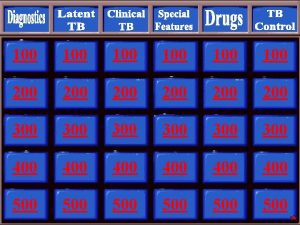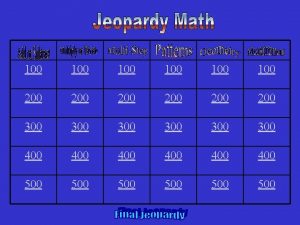Analysis of the dielectron continuum in AuAu 200











![Data/cocktail Measurement [10 -5 counts/event] Predictions [10 -5 counts/event] 0. 15 -0. 7 Ge. Data/cocktail Measurement [10 -5 counts/event] Predictions [10 -5 counts/event] 0. 15 -0. 7 Ge.](https://slidetodoc.com/presentation_image_h2/6be23592d0b50231625692a01a9835e9/image-12.jpg)












- Slides: 24

Analysis of the dielectron continuum in Au+Au @ 200 Ge. V with PHENIX Alberica Toia for the PHENIX Collaboration • Physics Motivation • Analysis Strategy (765 M events) – Cuts • Single electron cuts • Electron pair cuts: remove hit sharing – Spectra: Foreground, Background (mix events), Subtracted – Efficiency / Acceptance • Cocktail & theory comparison 1

Physics Motivation: em probes e- e+ Freeze-out Ex p an si o n time Hadronization QGP Thermaliztion Hard Scattering space Au electro-magnetic radiation: g, e+e-, m+mrare, emitted “any time”; reach detector unperturbed by strong final state interaction Au 2

e+e- Pair Continuum at RHIC Expected sources • Light hadron decays – Dalitz decays p 0, h – Direct decays r/w and f • Hard processes – Charm (beauty) production – Important at high mass & high p. T – Much larger at RHIC than at the SPS • Cocktail of known sources – Measure p 0, h spectra & yields – Use known decay kinematics – Apply detector acceptance – Fold with expected resolution Possible modifications Chiral symmetry restoration continuum enhancement modification of vector mesons thermal radiation charm modification exotic bound states esuppression (enhancement) e+ R. Rapp nucl-th/0204003 3

Electron Identification PHENIX optimized for Electron ID • track + • Cherenkov light RICH + • shower EMCAL Charged particle tracking: DC, PC 1, PC 2, PC 3 and TEC Excellent mass resolution (1%) All charged tracks RICH cut Real Net signal p e- Background Energy-Momentum Pair cuts (to remove hit sharing) PC 3 e+ DC PC 1 magnetic field & tracking detectors 4

Combinatorial Background Which belongs to which? Combinatorial background g e+ eg e+ ep 0 g e+ e. PHENIX 2 arm spectrometer acceptance: d. Nlike/dm ≠ d. Nunlike/dm different shape need event mixing like/unlike differences preserved in event mixing Same normalization for like and unlike sign pairs RATIO -- --- Foreground: same evt --- Background: mixed evt BG fits to FG 0. 1% 5

Combinatorial Background • Different independent normalizations used to estimate sys error – Measured like sign yield – Event counting: Nevent / Nmixed events – Poisson assumption: N± = 2√N++N— – Track counting: ‹N±› = ‹N+›‹N-› • All the normalizations agree within 0. 5% Systematic uncertainty: 0. 25% e+ e po e+ e - --- Foreground: same evt --- Background: mixed evt 6

Photon conversion rejection g e+e- at r≠ 0 have m≠ 0 (artifact of PHENIX tracking) • effect low mass region • have to be removed Conversion removed with orientation angle of the pair in the magnetic field r ~ mee Photon conversion --- without conversion --- with conversion beampipe air Support structures Mass [Ge. V/c 2] 7

Subtracted spectrum BG normalized to Measured like sign yield Integral: 180, 000 above p 0: 15, 000 All the pairs Combinatorix Signal Green band: systematic uncertainty • Acceptance • Efficiency 8 • Run-by-run

Signal to Background • Very low signal to background ratio in the interesting region main systematic uncertainty ssignal/signal = s. BG/BG * BG/signal 0. 25% large!!! Yellow band: error on combinatorial background normalization Green band: other systematics 9

A closer look at resonances Agreement with other analyses phi A. Kozlov, K. Ozawa J/psi Upsilon? ? ? H. Pereira, T. Gunji 10

Cocktail comparison • Data and cocktail absolutely normalized • Cocktail from hadronic sources • Charm from PYTHIA Predictions are filtered in PHENIX acceptance • Good agreement in p 0 Dalitz • Continuum: hint for enhancement not significant within systematics • What happens to charm? • Single e pt suppression • angular correlation? ? ? • LARGE SYSTEMATICS!11
![Datacocktail Measurement 10 5 countsevent Predictions 10 5 countsevent 0 15 0 7 Ge Data/cocktail Measurement [10 -5 counts/event] Predictions [10 -5 counts/event] 0. 15 -0. 7 Ge.](https://slidetodoc.com/presentation_image_h2/6be23592d0b50231625692a01a9835e9/image-12.jpg)
Data/cocktail Measurement [10 -5 counts/event] Predictions [10 -5 counts/event] 0. 15 -0. 7 Ge. V/c 2 17. 8 ± 3. 8 ± 1. 50 12. 3 1. 1 -2. 5 Ge. V/c 2 0. 67 ± 0. 50 ± 0. 11 1. 16 12

Comparison with theory • calculations for min bias • QGP thermal radiation included • Systematic error too large to distinguish predictions • Mainly due to S/B • Need to improve HBD R. Rapp, Phys. Lett. B 473 (2000) R. Rapp, Phys. Rev. C 63 (2001) 13 R. Rapp, nucl/th/0204003

A Hadron Blind Detector (HBD) for PHENIX signal electron Cherenkov blobs partner positron needed for rejection e- e+ q pair opening angle ~1 m S/B ~ 100 x • Irreducible charm background • S/B increased by factor 100 I. Ravinovich • Dalitz rejection via opening angle – Identify electrons in field free region – Veto signal electrons with partner HBD concept: – windowless CF 4 Cherenkov detector – 50 cm radiator length – Cs. I reflective photocathode – Triple GEM with pad readout 14 Construction/installation 2005/2006

Summary & Outlook • First dielectron continuum measurement at RHIC – Despite of low signal/BG – Thanks to high statistics – Good understanding of background normalization • Measurement consistent with cocktail predictions within the errors – Improvement of the systematic uncertainty • HBD upgrade will reduce background great improvement of systematic and statistical uncertainty “The most beautiful sea hasn't been crossed yet. And the most beautiful words I wanted to tell you I haven't said yet 15. . . “ (Nazim Hikmet)

Backup 16

Single electron cuts • Event cut: – zvertex <= 25 • Single electron cuts: – Pt: – Ecore – Match PC 3 & EMC • PC 3 (Phi+z) • EMC (Phi+z) = >= 150 Me. V – 20 Ge. V 150 Me. V < < 3 sigma – Dispmax < – N 0 min >= – dep >= showers NOT removed) – chi 2/npe 0 < – Quality = 5 (ring displacement) 3 tubes -2 sigma (overlapping 10 63, 51, 31 17

Pair cuts DC ghosts (like sign): fabs(dphi) < 0. 1 rad fabs(dz) < 1. 0 cm RICH ghosts (like and unlike sign) Post Field Opening Angle < 0. 988 --- Foreground: same evt --- Background: mixed evt like Cos(PFOA) 18

Systematic error • Systematic error of simulation – Acceptance difference between real/simulation is less than: 3%. – Single e e. ID efficiency difference between real/simulation is less than 8. 8%. • Dep < 1%, emcsdphie < 1%, emcsdze < 1%, n 0 < 7%, chi 2/npe 0 < 1%, disp < 5%. • Systematic error of real data – Stability of acceptance: 5% – Stability of e. ID efficiency: 5% • Other correction factor – Embedding efficiency < 10% (Run 2 7%). • Background Normalization 19

Acceptance filter • Decoupling acceptance – efficiency corrections • Define acceptance filter (from real data) • Correct only for efficiency IN the acceptance • “Correct” theory predictions IN the acceptance • Compare ACCEPTANCE FILTER charge/p. T q 0 Roughly parametrized from data f 0 z vertex 20

Efficiency 2 sets of simulations of dielectron pairs • White in mass (0 -4 Ge. V) • White in p. T (0 -4 Ge. V) • Vertex(-30, 30), rapidity (1 unit), phi (0, 2 p) • Linearly falling mass (0 -1 Ge. V) • Linearly falling p. T (0 -1 Ge. V) • Vertex(-30, 30), rapidity (1 unit), phi (0, 2 p) 2 D efficiency corrections: Mass vs p. T 21

Single e distribution: Poisson 0 -10% 10 -20% 20 -30% 30 -40% 22

Normalization of combinatorial background Same normalization used for like and unlike sign pairs 4 different (independent) normalizations: • Akiba : Nevent / Nmixed events • Hemmick: N± = 2√N++N— • Zajc: ‹N±› = ‹N+›‹N-› • Drees: 0. 5*( (Integral. FG++(0. 15 -4 Ge. V) / Integral. BG++(0. 15 -4 Ge. V)) + (Integral. FG-- (0. 15 -4 Ge. V) / Integral. BG-- (0. 15 -4 Ge. V)) ) Normalization factors [10 -2] • akiba: 8. 74 • hemmick: 8. 69 • zajc: 8. 71 • drees: 8. 70 All normalizations agree within 0. 5% upper limit: Integral in charm region=0 Normalization factor 8. 75 23

The unfiltered calculations • black: our standard cocktail • red : hadronic spectrum using the VACUUM rho spectral function • green: hadronic spectrum using the IN-MEDIUM rho spectral function • blue : hadronic spectrum using a rho spectral function with DROPPING MASS • magenta : QGP spectrum using the HTL-improved p. QCD rate 24
 300+300+400
300+300+400 Auau
Auau Auau
Auau Auau
Auau Auau
Auau 200+200+100+100
200+200+100+100 200 + 200 = 400
200 + 200 = 400 300+300+200+200
300+300+200+200 200+200+100
200+200+100 100 200 300
100 200 300 200+200+300
200+200+300 Hình ảnh bộ gõ cơ thể búng tay
Hình ảnh bộ gõ cơ thể búng tay Bổ thể
Bổ thể Tỉ lệ cơ thể trẻ em
Tỉ lệ cơ thể trẻ em Chó sói
Chó sói Tư thế worm breton
Tư thế worm breton Hát lên người ơi alleluia
Hát lên người ơi alleluia Môn thể thao bắt đầu bằng từ chạy
Môn thể thao bắt đầu bằng từ chạy Thế nào là hệ số cao nhất
Thế nào là hệ số cao nhất Các châu lục và đại dương trên thế giới
Các châu lục và đại dương trên thế giới Cong thức tính động năng
Cong thức tính động năng Trời xanh đây là của chúng ta thể thơ
Trời xanh đây là của chúng ta thể thơ Mật thư anh em như thể tay chân
Mật thư anh em như thể tay chân 101012 bằng
101012 bằng

